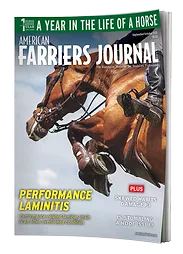The equine foot is a window into a horse’s overall health.
"The foot tells you everything, really,” New Zealand farrier Mark Isaacs tells the Otago Daily Times. “If they’re crook, a line will come down the horse’s foot; it’s a ring that goes round the outside of the foot. Often that will tell you if it’s gone from good pasture to bad pasture.”
So getting the shoeing right is crucial for Isaacs, who is kept busy shoeing all the horses at White Robe Lodge, as well as for other Wingatui-based trainers.
"When the grass grows in the spring, their feet take off,” he says. “Every horse is different. Some Thoroughbreds don’t have much heel, so you have to be so careful. At the end of the day, no foot, no horse.”
Isaacs keeps busy around race days as horses run in lighter aluminum plates when they line up at the races.
“They do wear out quicker but, of course, they are lighter,” he says. “The aluminums have got a wider base, which is very good for their feet. But if an aluminum plate wears too much it can get slippery.
“With the Thoroughbreds, when they first come in to work, we will put a reasonable-size shoe on them, weight-wise. And when they start galloping, we put them in a smaller steel shoe. All the hacks and ponies have road shoes on. They would just wear out too quick.’”
As a former amateur jumps jockey who won a steeplechase race at Wingatui — “then I had a bad crash in the next one so that was enough for me” — and a current clerk of the course at Otago Racing Club meetings, he is well aware how quickly a horse’s fate can change with one stride.
“We can get out of a car and twist our ankle; we get away with a lot. But because the horse is going at such a speed, it only needs to stand in a wee hole or on something sharp and it’ll soon slow down.”
Isaacs estimates about 80% of his farrier work is with Thoroughbreds, the remainder comprising show ponies and show hacks.
Aside from the odd small kick, Isaacs has avoided major injury from racehorses.
His worst injury came with one of his own horses in October 2010. The horse kicked, knocking Isaacs unconscious, fracturing his skull and eye socket, and leaving him with more than 300 stitches in his face.
“I was in intensive care for a few days, but I was back shoeing within a month,” Isaacs says.
He might shoe an average of 10 horses a day during the summer before heading home to his Island Park Stud at Waldronville, so it’s “horses, horses, horses.”
Still, he wouldn’t have it any other way.
“I took a wee boy out who thought he might want to be a farrier and I said to him, ‘Do you like horses?’
“He said, ‘I’m not sure.’ So I said, ‘You’re wasting your time.’”






